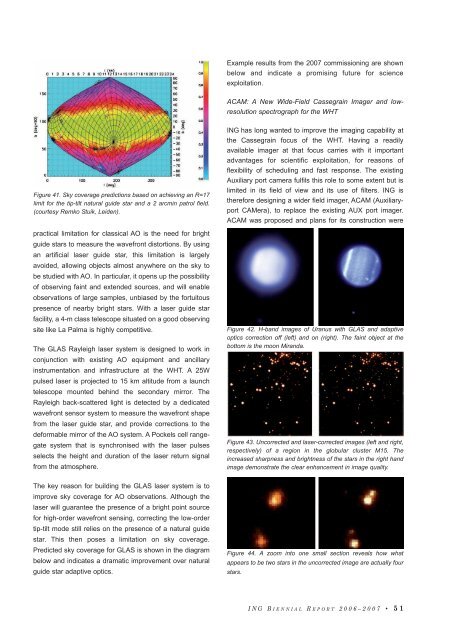PDF (6M) - Isaac Newton Group of Telescopes - Instituto de ...
PDF (6M) - Isaac Newton Group of Telescopes - Instituto de ...
PDF (6M) - Isaac Newton Group of Telescopes - Instituto de ...
You also want an ePaper? Increase the reach of your titles
YUMPU automatically turns print PDFs into web optimized ePapers that Google loves.
Example results from the 2007 commissioning are shown<br />
below and indicate a promising future for science<br />
exploitation.<br />
ACAM: A New Wi<strong>de</strong>-Field Cassegrain Imager and lowresolution<br />
spectrograph for the WHT<br />
Figure 41. Sky coverage predictions based on achieving an R=17<br />
limit for the tip-tilt natural gui<strong>de</strong> star and a 2 arcmin patrol field.<br />
(courtesy Remko Stuik, Lei<strong>de</strong>n).<br />
practical limitation for classical AO is the need for bright<br />
gui<strong>de</strong> stars to measure the wavefront distortions. By using<br />
an artificial laser gui<strong>de</strong> star, this limitation is largely<br />
avoi<strong>de</strong>d, allowing objects almost anywhere on the sky to<br />
be studied with AO. In particular, it opens up the possibility<br />
<strong>of</strong> observing faint and exten<strong>de</strong>d sources, and will enable<br />
observations <strong>of</strong> large samples, unbiased by the fortuitous<br />
presence <strong>of</strong> nearby bright stars. With a laser gui<strong>de</strong> star<br />
facility, a 4-m class telescope situated on a good observing<br />
site like La Palma is highly competitive.<br />
The GLAS Rayleigh laser system is <strong>de</strong>signed to work in<br />
conjunction with existing AO equipment and ancillary<br />
instrumentation and infrastructure at the WHT. A 25W<br />
pulsed laser is projected to 15 km altitu<strong>de</strong> from a launch<br />
telescope mounted behind the secondary mirror. The<br />
Rayleigh back-scattered light is <strong>de</strong>tected by a <strong>de</strong>dicated<br />
wavefront sensor system to measure the wavefront shape<br />
from the laser gui<strong>de</strong> star, and provi<strong>de</strong> corrections to the<br />
<strong>de</strong>formable mirror <strong>of</strong> the AO system. A Pockels cell rangegate<br />
system that is synchronised with the laser pulses<br />
selects the height and duration <strong>of</strong> the laser return signal<br />
from the atmosphere.<br />
ING has long wanted to improve the imaging capability at<br />
the Cassegrain focus <strong>of</strong> the WHT. Having a readily<br />
available imager at that focus carries with it important<br />
advantages for scientific exploitation, for reasons <strong>of</strong><br />
flexibility <strong>of</strong> scheduling and fast response. The existing<br />
Auxiliary port camera fulfils this role to some extent but is<br />
limited in its field <strong>of</strong> view and its use <strong>of</strong> filters. ING is<br />
therefore <strong>de</strong>signing a wi<strong>de</strong>r field imager, ACAM (Auxiliaryport<br />
CAMera), to replace the existing AUX port imager.<br />
ACAM was proposed and plans for its construction were<br />
Figure 42. H-band images <strong>of</strong> Uranus with GLAS and adaptive<br />
optics correction <strong>of</strong>f (left) and on (right). The faint object at the<br />
bottom is the moon Miranda.<br />
Figure 43. Uncorrected and laser-corrected images (left and right,<br />
respectively) <strong>of</strong> a region in the globular cluster M15. The<br />
increased sharpness and brightness <strong>of</strong> the stars in the right hand<br />
image <strong>de</strong>monstrate the clear enhancement in image quality.<br />
The key reason for building the GLAS laser system is to<br />
improve sky coverage for AO observations. Although the<br />
laser will guarantee the presence <strong>of</strong> a bright point source<br />
for high-or<strong>de</strong>r wavefront sensing, correcting the low-or<strong>de</strong>r<br />
tip-tilt mo<strong>de</strong> still relies on the presence <strong>of</strong> a natural gui<strong>de</strong><br />
star. This then poses a limitation on sky coverage.<br />
Predicted sky coverage for GLAS is shown in the diagram<br />
below and indicates a dramatic improvement over natural<br />
gui<strong>de</strong> star adaptive optics.<br />
Figure 44. A zoom into one small section reveals how what<br />
appears to be two stars in the uncorrected image are actually four<br />
stars.<br />
ING BIENNIAL R EPORT 2006–2007 • 51
















